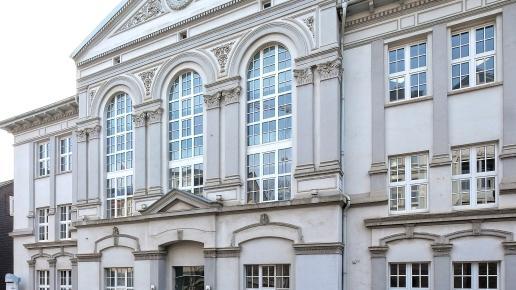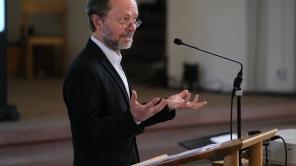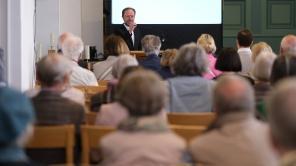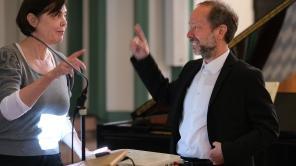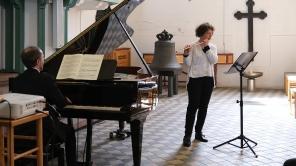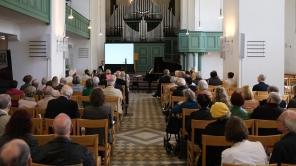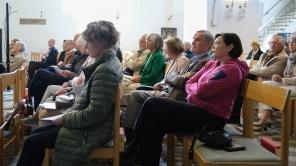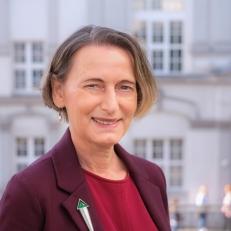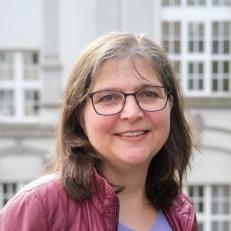Saturdays at 12
Readings by authors, musical delicacies, discussions with pros and cons, lectures on topics from the world of science - the "Saturdays at 12" format in the foyer of the lecture hall center on the Lower Castle campus is set to be a colorful one.
Right in the heart of the city and at the best market time in Siegen, the House of Science invites all citizens to get to know the university's new "living room" with a view of the Lower Castle and learn something new in an entertaining way.
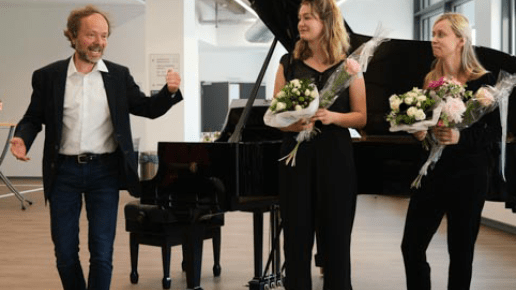
When physicists go hunting for neutrinos
"Saturdays at 12" starts the winter semester on October 25, 2025.
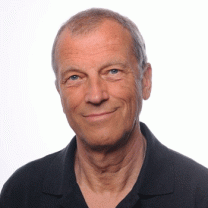
"Saturdays at 12" starts the winter semester on October 25, 2025. The guest is physicist Dr. Christian Spiering from DESY in Zeuthen. Spiering will have his recently published non-fiction book with him - "Das seltsste Teilchen der Welt. On the hunt for the neutrino" (12.00 noon, US - S 002, Obergraben 25, Siegen). A stolen physicist and a missing researcher: the elementary particle physicist uses seven portraits to tell the story of the hunt for the neutrino through time.
As you read this text, trillions of neutrinos are flying unnoticed through your body. The "ghost particles" are a key to understanding the universe. But how do you catch something that doesn't want to be caught? Christian Spiering is an internationally renowned neutrino researcher. Here he tells the exciting story of a 100-year hunt that has taken researchers to the South Pole, deep underground, between the fronts of the Cold War and often to the brink of despair - from Lise Meitner to Wolfgang Pauli and right up to the present day. Comprehensible and exciting like a science thriller. (Hanser publishing house)
Music at 12" will become "Music at 8" on November 15. The House of Science joins the Siegen Night of Music. There will be jazz singing with Stephanie Neigel from 8 p.m. in the foyer of the Hörsaalzentrum on the Unteres Schloss campus. The multi-instrumentalist Stephanie Neigel will be performing from her latest work, the duo album "Phalleé & Baldu", in which she performs under her stage name and explores the art-pop universe in a new way. She will be accompanied by Hanno Busch, who has been Professor of Jazz Guitar at the HfMT Cologne since 2024 and is one of the most sought-after guitarists of his time internationally. Neigel will also be heard on the guitar and piano. Their handmade music between jazz and pop is captivating, has clever lyrics, they groove, they improvise, they laugh and cry - good music, nothing more and nothing less.
The year 2025 is (also) marked by the commemoration of the Peasants' War of 1525, and a state exhibition is dedicated to this topic, not least in Mühlhausen, Thuringia. One of its advisors is the Göttingen church historian Prof. Dr. Thomas Kaufmann. The Leibniz Prize winner has also written a non-fiction book on the subject of "The Peasants' War. A media history". Kaufmann will be a guest on "Wissenschaft um 12" on December 13, 2025 (US - S 002, Obergraben 25 in Siegen).
About the content: Alongside the Reformation, the Peasants' War marks the threshold to the modern era. Unlike the reformers, however, its protagonists were unable to push through their demands, some of which sounded modern. The peasants' uprising was bloodily suppressed. The Peasants' War has always been interpreted ideologically - even at the time, according to Kaufmann, it was primarily a media event. Through extensive source studies, Kaufmann exposes ideological distortions and presents a captivating reinterpretation of this important event. With passion and expertise, he opens up a completely new perspective on the Peasants' War. It becomes clear that the Peasants' War was not only a battle for social justice, but also a battle for the sovereignty of interpretation. (Verlag Herder)
"Music at 12" with Lena Maria Kramer will probably be repeated in January 2026. A short musical journey around the world will be presented: Songs and arias by Otto Nicolai, Carlisle Floyd, Leonard Bernstein.... The exact Saturday date will be announced shortly.
"No oligarch yacht has ever been built in Russia"
Eastern European historian Prof. Manfred Hildermeier gave a lecture on Russia and the West at "Science at 12"
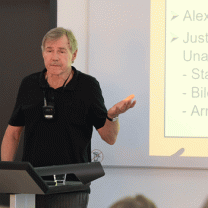
Is backwardness a dirty word, or is it the sober finding of a stage of development? Does backwardness offer the opportunity for development on the basis of tested innovation, or is it evidence of a company's own inability to innovate? At the very least, the concept of backwardness holds potential for discussion. Around 90 guests experienced this at "Science at 12" on the topic of Prof. Dr. Manfred Hildermeier's book "Die rückständige Großmacht. Russia and the West".
The historian of Eastern Europe from Göttingen invited the audience on a journey of knowledge through 1000 years of Russian history. The concept of backwardness was coined early on by political and social elites in Russia. Hildermeier: "The awareness of our own backwardness still prevails today." As early as the 15th century, at the time of Metropolitan Isidor of Moscow, the description of a journey through the West points in this direction. Russia was considered inferior to Western construction, technology and medicine, for example. Hildermeier: "This view formed the basic tone of the next three centuries." Kievan Rus' felt itself to be on the fringes of the West, not least on the basis of various marital arrangements, but nonetheless part of it. It was not until the schism of 1054 that contacts were broken off due to religious differences and a rift opened up between East (Church) and West (Church). In 1453 Constantinople fell to the Ottomans. Around a century and a half later, this opened up the basis for the Translatio Imperio "Moscow the 3rd Rome".
In the middle of the 16th century, Tsar Ivan IV began to recruit craftsmen from the "West", primarily from Germany. His successor Boris Godunov and the first Romanov Tsar Michael continued these efforts. Peter the Great is regarded as the founder of a strong western orientation. Hildermeier: "He opened the window to Europe particularly wide." Under Catherine the Great, a new type of Russian nobleman emerged: education was provided by teachers from the West; the young nobles went on cavalier tours through Europe. Hildermeier: "The Russian nobility became what Peter the Great would have wanted it to be." A huge gap remained between developments in the city and the country.
The invasion of Russia by Napoleon was followed by a return to Russian culture and Russian values at the beginning of the 19th century. A Russian-style anti-Western conservatism emerged, consisting of the trinity of autocracy, Orthodoxy and national consciousness. Hildermeier: "The Tsarist Empire became the gendarme of Europe." A secret police force was installed. Nevertheless, according to Hildermeier, there were also opposing movements. An education system based on the Prussian model was established; industry also developed with peasant workers, civil servants were trained at universities for the first time - qualifications dominated origin. Russia's defeat in the Crimean War (1853-56) triggered further developments, particularly with regard to weapons technology and the army. Western investment in Russia increased.
The Bolshevik revolution of 1917 was intended as an alternative to Western capitalism. The USA became the main ideological opponent. Nevertheless, the United States and the entrepreneur Ford in particular were revered. Hildermeier: "Russian Marxism was based on an ideology of technologization. The country was to be modernized." Stalin introduced the centrally planned economy: "The overcrowding of the plans justified any terror." Two and a half five-year plans formed the foundation of modern industry. Hildermeier: "The driving force was the state. The technical knowledge and modern machines were supplied by the capitalist West."
The Cold War put an end to this cooperation. Industries deinstalled from defeated Germany and deported scientists meant that the Soviet Union was unable to keep pace with the German economic miracle, for example. Two core requirements crystallized in the Soviet Union: the creation of living space and the supply of cars to the population. In the 1960s, over 12 million small private apartments were built that were affordable for an urban middle class. Under Brezhnev there was a kind of social contract: no say, but more prosperity. The "Volga", a FIAT offshoot, also became affordable for the middle class.
With the end of the USSR at the beginning of the 1990s, many things took a turn for the worse from the population's point of view. Yeltsin plunged the country into economic chaos with high levels of corruption and crime. This period gave birth to the oligarchs. Hildermeier: "This situation elevated Putin to office." The boom in oil prices led to the "golden age" of the early 2000s: "Russia learned to be an insecure and clumsy rich country". The end came with the global economic crisis in 2008. In 2014/15, at the time of the annexation of Crimea, the Russian economy was still "bobbing along". Industry was not modernized; a lot of money was spent on arming the army. The export of domestic natural resources financed the import of Western goods.
Without the consistent implementation of the embargoes imposed on Russia, Hildermeier believes that Putin could continue the war against Ukraine, which began in 2022, for years to come. And: "No oligarch yacht has ever been built in Russia."
The stereotype of the flawed human being
Prof. Martina Heßler as a guest: Sisyphus' mountain gets steeper and steeper, the stone gets bigger and heavier
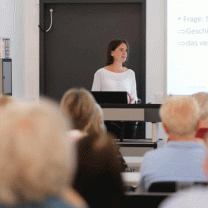
"How does technology shape society?" - This opening question from moderator Prof. Dr. Ralph Dreher (Technology Didactics at the University of Siegen) set the scene for a two-hour event at "Science at 12". The guest was technology historian Prof. Dr. Martina Heßler from TU Darmstadt. Her book "Sisyphos im Maschinenraum. A History of the Fallibility of Humans and Technology" was nominated for the German Non-Fiction Prize 2025. Ever since industrialization, there has been the stereotype that machines work better than people, says Martina Heßler.
Technological chauvinism systematically devalues humans in comparison to machines. This attitude represents a basic configuration of Western modernity. Faulty humans lead to the conclusion that they must be replaced by machines. Autonomous driving is apostrophized to eliminate human error. Autonomous drones kill "more ethically" than humans. Reception robots in hotels have better manners than humans..... Martina Heßler: "I am investigating the figure of the flawed human being as a stereotype in different areas of life. The arguments have been repeated for over 200 years."
The figure was established in the early 19th century. The author condenses arguments in her book and is aware that her depictions are not always objective. The consequences of the stereotype are a) the conviction that people are overwhelmed, b) an increase in technological errors and c) a constant increase in technology to correct errors - Sisyphus. Due to increasingly complex technology, which is also increasingly prone to error, Sisyphus' mountain seems to be getting higher and steeper, the stone heavier and bigger. During her research work, the author was reminded several times of the constantly growing bureaucratic system in Germany.
With regard to the factories, the Scottish physician and scientist Andrew Ure emphasized the weakness of human nature and human fallibility in 1895. People are sinful, fallible, imperfect and have physical weaknesses. In 1974, a list of human shortcomings appeared in a VDI magazine: Slowness, irregularity, lack of precision, tendency to poorly organized knowledge, slow learning to the point of being incapable of criticism... The elimination of human error was equivalent to the elimination of humans in the factory. In 2016, the idea of putting up a computer as a more suitable candidate - "Watson for President" - emerged during the US election campaign.
In the 1950s, there was a fear of nuclear war and, above all, that people could make irrational and emotional decisions and trigger such a conflict. The computer, which could think better than humans, was seen as the solution. The following ideal image was attributed to the machine: precise, fast, consistent, regular, reliable, predictable, plannable, objective, rational, rule-abiding. The fact that the Soviet Union did not launch a nuclear counterattack against NATO on September 26, 1983 is thanks to Soviet Lieutenant Colonel Stanislav Petrov and his decision not to trust a false alarm from the early warning system. The false alarm was triggered by the sun reflecting off clouds.
The need for safety is high among people who make mistakes. When driving a car, ABS is designed to avoid the moment of shock. So did the computer come at just the right time? If so, for what? The spiral of errors, troubleshooting, technology and ever more complex technology continues. According to Heßler, some problems could be solved by changing human behavior. For example, cars are easier to control at low speeds than at high speeds. Less car traffic would benefit the safety of road users. This restriction would set limits to the constant higher and further, at least in certain areas. Prof. Martina Heßler's presentation was followed by an intensive and exciting discussion lasting around an hour.
Fact or fake?
Mirko Drotschmann was a guest on "Samstags um 12", and the HDW puzzle found a winner
"Fact or fake?" - this was the question on the agenda of the House of Science as part of the Open
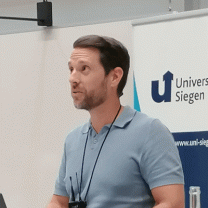
University in the courtyard of the Lower Castle in Siegen. Presenter and YouTuber Mirko Drotschmann broadened the minds of around 600 predominantly young visitors in the Schadeberg lecture hall to the topic of fake news. He illustrated how reports and photos can be checked for credibility and origin. At the end, he was sure to receive repeated thunderous applause as well as a long line of fans waiting to take selfies.
The HDW's "Fact or Fake?" puzzle was solved by a number of participants. Five of them received the "Siegerlandquiz" card game as a prize. Solution: 1) Napoleon Bonaparte could not have given the order to shoot the Sphinx's nose off during his Egyptian campaign, as a sketch published by Frederic Louis Norden in 1755 already shows the Sphinx without a nose. Napoleon was not born until 1769. 2) Thomas Edison invented the first carbon filament lamp in 1879, which burned for several days. In return, he improved the inventions of others. 3) The famous Bayeux Tapestry in Normandy is an embroidery. Scenes from the Battle of Hastings (1066) are told as embroidery. 4) The period from the building of the pyramids of Giza to the birth of Cleopatra (approx. 2530 years) is longer than the period between the birth of Cleopatra and the invention of the iPhone (approx. 2075 years). 5) Peter Paul Rubens was born in a house that no longer exists on the current site of the Realschule am Oberen Schloss. A plaque in the castle courtyard commemorates this. 6) Do giraffes, humans and mice all have the same number of neck vertebrae? Yes. Most mammals have seven cervical vertebrae. 8) The sun is the central star of the solar system. Since it has 99.86% of the total mass of the system, it is very close to the barycenter of the solar system. The terrestrial planets Mercury, Venus, Earth and Mars, which make up the inner part of the planetary system, follow in order of distance from the sun.
"One farm and eleven siblings"
Literature / Science at 12
25 November 2023, 12 noon, Building US - S 002, Obergraben 25 (former Bekleidungshaus Sauer) Prof. Dr. Ewald Frie (University of Tübingen)
Moderation. Prof. Dr. Bärbel Kuhn (University of Siegen)
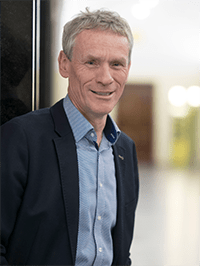
Proud rural agriculture with livestock markets, self-sufficiency and hard backbreaking work disappeared rapidly and yet quietly in the course of the 1960s. Ewald Frie uses the example of his family to tell the story of this major turning point. With just a few strokes, using meaningful scenes and examples, he shows how his parents' world came to an end, his siblings followed other life plans and the general social change gripped the country.
Breeding bulls for the monthly auction, cows and pigs in the pasture, horses in front of the plow, a garden for stockpiling - the farm profitably managed by parents, children and helpers. Farm life in the 1950s seems closer to the Middle Ages than to our own times. But then everything changes: once prosperous and respected farmers are suddenly seen as poor and backward despite all the modernization, their children smell of stables and feel ashamed. The Catholic Church shows ways out of the rural world with new youth work. The welfare state helps with training and handing over farms. Even in the 1970s, the world in the countryside was a completely different place. You look back in amazement, the change was so quiet: "My God, I lived through that, it seems like another century." Ewald Frie asked his ten siblings, born between 1944 and 1969, how they experienced this time. His brilliantly written book brings the great upheaval to life with unerring laconicism. (Source: Verlag Beck)
